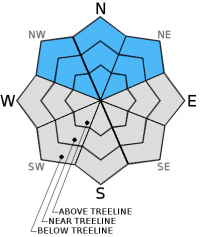| Friday | Friday Night | Saturday | |
|---|---|---|---|
| Weather: | Partly cloudy with slight chance of snow in the afternoon | Mostly cloudy with snow becoming likely after midnight | Snow |
| Temperatures: | 36 to 43 deg. F. | 21 to 29 deg. F. | 26 to 33 deg. F. |
| Mid Slope Winds: | Southwest | Southwest | Southwest |
| Wind Speed: | 15 to 20 mph with gusts to 35 mph increasing to 25 to 35 mph with gusts to 50 mph in the afternoon | 25 to 35 mph with gusts to 50 mph | 15 to 20 mph with gusts to 35 mph |
| Expected snowfall: | 0 | 3 to 5 | 2 to 5 |
| Friday | Friday Night | Saturday | |
|---|---|---|---|
| Weather: | Partly cloudy with slight chance of snow in the afternoon | Mostly cloudy with snow becoming likely after midnight | Snow |
| Temperatures: | 33 to 40 deg. F. | 18 to 25 deg. F. | 22 to 29 deg. F. |
| Ridge Top Winds: | Southwest | Southwest | Southwest |
| Wind Speed: | 50 to 55 mph with gusts to 80 mph increasing to 60 to 65 mph with gusts to 100 mph in the afternoon | 60 to 70 mph with gusts to 100 mph | 50 to 55 mph with gusts to 85 mph decreasing to 35 to 40 mph with gusts to 60 mph in the afternoon |
| Expected snowfall: | 0 | 3 to 5 | 2 to 5 |
























